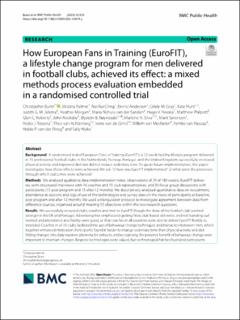| dc.contributor.author | Bunn, Christopher | |
| dc.contributor.author | Palmer, Victoria | |
| dc.contributor.author | Chng, Nai Rui | |
| dc.contributor.author | Andersen, Eivind | |
| dc.contributor.author | Gray, Cindy M. | |
| dc.contributor.author | Hunt, Kate | |
| dc.contributor.author | Jelsma, Judith G. M. | |
| dc.contributor.author | Morgan, Heather | |
| dc.contributor.author | Pereira, Hugo V. | |
| dc.contributor.author | Philpott, Matthew | |
| dc.contributor.author | Rooksby, John | |
| dc.contributor.author | Silva, Marlene N. | |
| dc.contributor.author | Sørensen, Marit | |
| dc.contributor.author | Teixeira, Pedro J. | |
| dc.contributor.author | van Achterberg, Theo | |
| dc.contributor.author | van de Glind, Irene | |
| dc.contributor.author | Nijhuis-van der Sanden, Maria W. G. | |
| dc.contributor.author | Roberts, Glyn C. | |
| dc.contributor.author | Røynesdal, Øystein B. | |
| dc.contributor.author | Wyke, Sally | |
| dc.date.accessioned | 2023-10-12T15:21:19Z | |
| dc.date.available | 2023-10-12T15:21:19Z | |
| dc.date.created | 2023-04-27T14:20:37Z | |
| dc.date.issued | 2023 | |
| dc.identifier.citation | BMC Public Health. 2023, 23(2023), Artikkel 526. | en_US |
| dc.identifier.issn | 1471-2458 | |
| dc.identifier.uri | https://hdl.handle.net/11250/3096190 | |
| dc.description | This article is licensed under a Creative Commons Attribution 4.0 International License, which permits use, sharing, adaptation, distribution and reproduction in any medium or format, as long as you give appropriate credit to the original author(s) and the source, provide a link to the Creative Commons licence, and indicate if changes were made. The images or other third party material in this article are included in the article’s Creative Commons licence, unless indicated otherwise in a credit line to the material. If material is not included in the article’s Creative Commons licence and your intended use is not permitted by statutory regulation or exceeds the permitted use, you will need to obtain permission directly from the copyright holder. | en_US |
| dc.description.abstract | Background: A randomised trial of European Fans in Training (EuroFIT), a 12-week healthy lifestyle program delivered in 15 professional football clubs in the Netherlands, Norway, Portugal, and the United Kingdom, successfully increased physical activity and improved diet but did not reduce sedentary time. To guide future implementation, this paper investigates how those effects were achieved. We ask: 1) how was EuroFIT implemented? 2) what were the processes through which outcomes were achieved?
Methods: We analysed qualitative data implementation notes, observations of 29 of 180 weekly EuroFIT deliveries, semi-structured interviews with 16 coaches and 15 club representatives, and 30 focus group discussions with participants (15 post-program and 15 after 12 months). We descriptively analysed quantitative data on recruitment, attendance at sessions and logs of use of the technologies and survey data on the views of participants at baseline, post program and after 12 months. We used a triangulation protocol to investigate agreement between data from difference sources, organised around meeting 15 objectives within the two research questions.
Results: We successfully recruited clubs, coaches and men to EuroFIT though the draw of the football club seemed stronger in the UK and Portugal. Advertising that emphasized getting fitter, club-based deliveries, and not ‘standing out’ worked and attendance and fidelity were good, so that coaches in all countries were able to deliver EuroFIT flexibly as intended. Coaches in all 15 clubs facilitated the use of behaviour change techniques and interaction between men, which together enhanced motivation. Participants found it harder to change sedentary time than physical activity and diet. Fitting changes into daily routines, planning for setbacks and recognising the personal benefit of behaviour change were important to maintain changes. Bespoke technologies were valued, but technological hitches frustrated participants.
Conclusion: EuroFIT was delivered as planned by trained club coaches working flexibly in all countries. It worked as expected to attract men and support initiation and maintenance of changes in physical activity and diet but the use of bespoke, unstable, technologies was frustrating. Future deliveries should eliminate the focus on sedentary time and should use only proven technologies to support self-monitoring and social interaction. | en_US |
| dc.language.iso | eng | en_US |
| dc.subject | football | en_US |
| dc.subject | intervention | en_US |
| dc.subject | mixed methods | en_US |
| dc.subject | physical activity | en_US |
| dc.subject | process evaluation | en_US |
| dc.subject | sedentary time | en_US |
| dc.title | How European Fans in Training (EuroFIT), a lifestyle change program for men delivered in football clubs, achieved its effect: A mixed methods process evaluation embedded in a randomised controlled trial | en_US |
| dc.type | Peer reviewed | en_US |
| dc.type | Journal article | en_US |
| dc.description.version | publishedVersion | en_US |
| dc.rights.holder | © The Author(s) 2023 | en_US |
| dc.source.pagenumber | 24 | en_US |
| dc.source.volume | 23 | en_US |
| dc.source.journal | BMC Public Health | en_US |
| dc.identifier.doi | 10.1186/s12889-023-15419-y | |
| dc.identifier.cristin | 2143857 | |
| dc.description.localcode | Institutt for idrett og samfunnsvitenskap / Department of Sport and Social Sciences | en_US |
| dc.source.articlenumber | 526 | en_US |
| cristin.ispublished | true | |
| cristin.fulltext | original | |
| cristin.qualitycode | 1 | |
